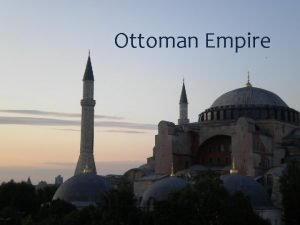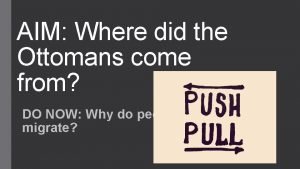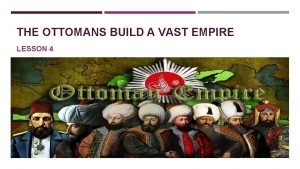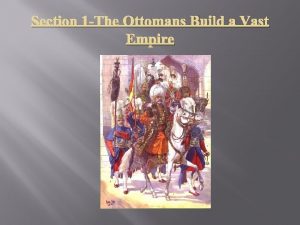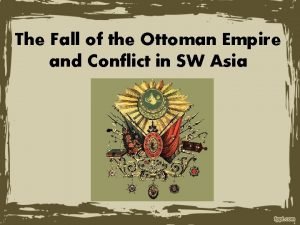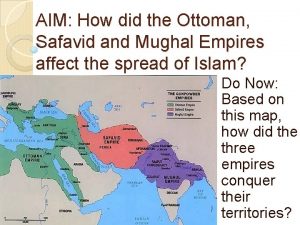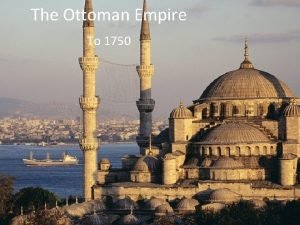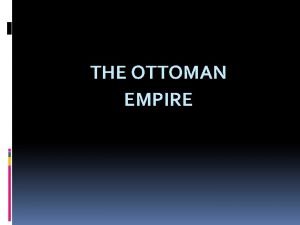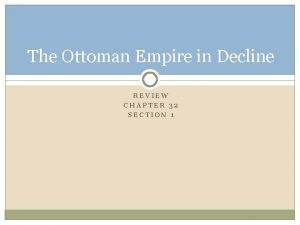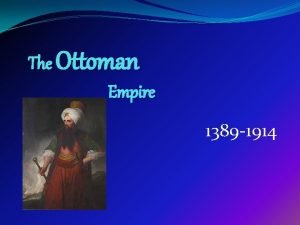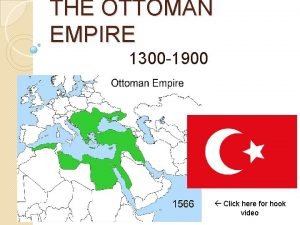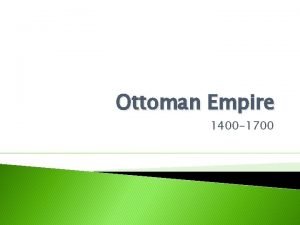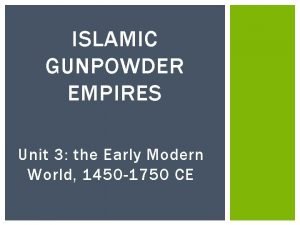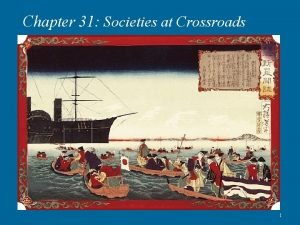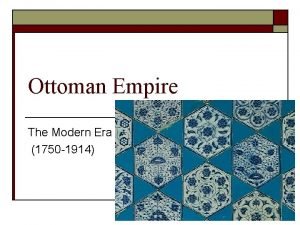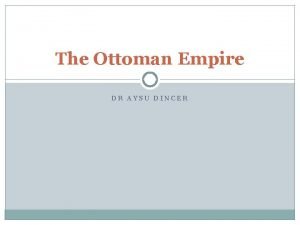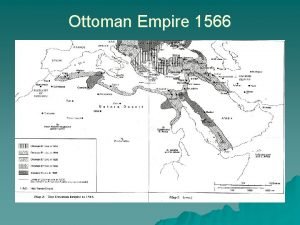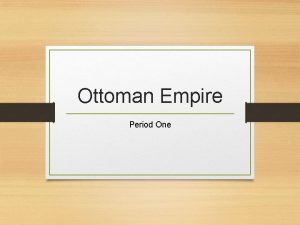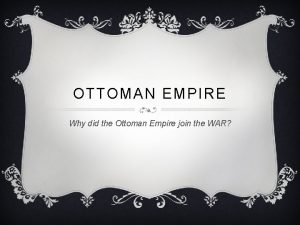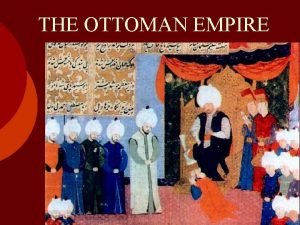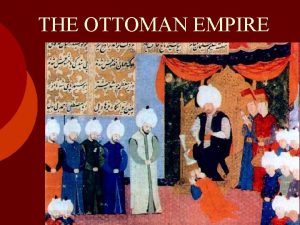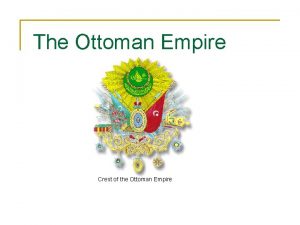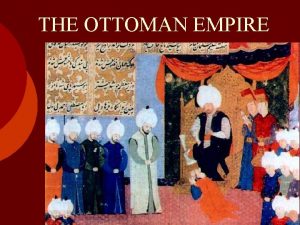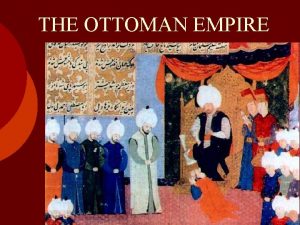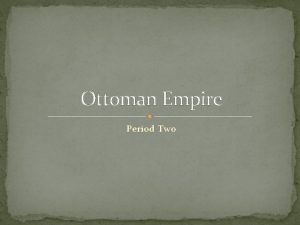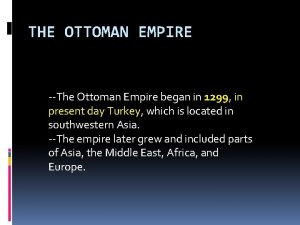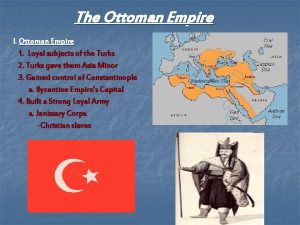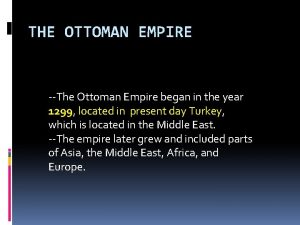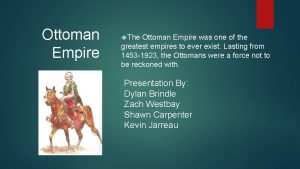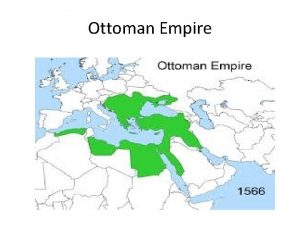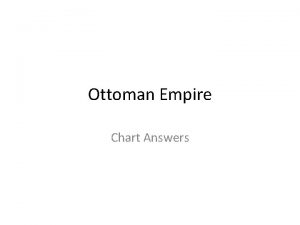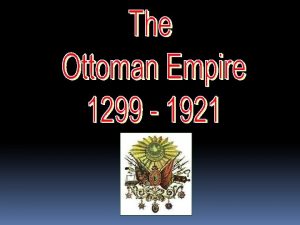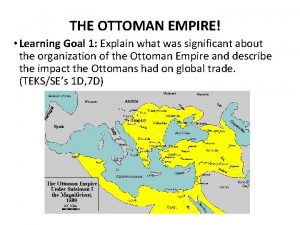Ottoman Empire Where did the Ottomans come from


























- Slides: 26

Ottoman Empire

Where did the Ottomans come from? • Name came from “Osman, ” a leader of a western Anatolian nomadic group who began expansionistic moves in the 14 th century. • Gradually these nomads took over Anatolia and became the border between Islam and Byzantine Christian


Sultan Mehmet II (1451 -1481) • Was one of the greatest Sultans • Called the Fatih (the Conqueror) • During his rule all of Turkey/Anatolia was brought under his control and the Byzantine Empire was defeated

• The Conquest of Constantinople = the Imperial phase of the Ottomans – Constantinople was renamed Istanbul – Mehmet II cleaned up the city and began building many mosques, markets, water fountains, baths, and other public facilities

The Sultan’s Bedchamber

• Mehmet II encouraged people to move to Istanbul – Bribed people from the Ottoman territories with homes and jobs The Grand Bazzar

• Many Jewish people, who were cruelly oppressed in Western Europe (aka Reconquista), moved to Istanbul and found Turkey to be a “haven” = a mass migration of Jewish people soon followed

• For the next 200 years the Ottomans will be a significant power in the Middle East – The Empire will continually expand

• Suleiman the “Lawgiver” – Sultanic law codes – Reformed the government – Balanced the budget – Reinforced Islamic law

• Suleiman the “Magnificent” – Grandeur of his court – Built palaces, mosques, schools, libraries, hospitals, roads, bridges, etc. – Cultural explosion (pax Ottomanica) – literary, artistic, and scientific achievements – Pasha Sinan – Suleiman’s Architect

“Blue” Mosque

• Conversion to Islam • Millet system (non-Muslims formed small communities and were allowed to keep their faith (Jewish or Christian) as long as they paid the jitza (a tax). • Local officials were replaced by Ottoman government officials

• Ottoman infrastructure – Built roads and bridges

Turkish Coffeehouses • During Ottoman times coffeehouses were places where men would come together and form public opinion. They first opened as a place for people to wait before going into the mosques for prayer and soon became a place where men would meet outside of the home.

• Professional groups started having “their” own coffeehouse; where people in their society would go to discuss important decisions and ideas.

• Coffee’s history in Turkey began in the 16 th century and is traditionally made by boiling very fine coffee powder in a cezve. • Traditionally served in small cups and drunk in one gulp.

Islam and Modesty – Women resided in seclusion in the harem – Purdah

– Sacred place, sanctuary, place of honor, respect, and religious purity – Private quarters of the family – not visited by nonfamily members (female visitors were allowed, but not common) – Boys remained with their mothers in the harem until the ages of 10 -11 The Harem

Ottoman Decline was caused by

– Weak leadership Selim II (aka the Sloth)

Corrupt government officials

– Powerful janissaries and janissary revolts

– Heavy taxes = revolts and unhappy peasantry

The Ottoman Empire was very diverse ethnically + nationalism = many groups wanting their freedom

– Loss of intellectualism = loss of innovation = fall behind the Europeans in technology
 Where did the ottomans come from?
Where did the ottomans come from? Where did the ottomans come from
Where did the ottomans come from Ottoman empire founder
Ottoman empire founder The ottomans build a vast empire
The ottomans build a vast empire How did the ottoman empire fall
How did the ottoman empire fall Why did the ottoman empire break up
Why did the ottoman empire break up Shiism
Shiism Ottoman empire 1750
Ottoman empire 1750 The ottoman empire grew and expanded after it conquered the
The ottoman empire grew and expanded after it conquered the Map of ottoman empire 1800
Map of ottoman empire 1800 Was the ottoman empire tolerant of other religions
Was the ottoman empire tolerant of other religions Ottoman empire gunpowder
Ottoman empire gunpowder Ottoman empire at its height
Ottoman empire at its height Ottoman empire 1400
Ottoman empire 1400 Ottoman safavid and mughal empire map
Ottoman safavid and mughal empire map How big was the islamic empire
How big was the islamic empire Gunpowder empires map
Gunpowder empires map Map of ottoman empire 1800
Map of ottoman empire 1800 Jagadai
Jagadai Ottoman empire
Ottoman empire Ottoman empire 1914
Ottoman empire 1914 Ottoman empire ducksters
Ottoman empire ducksters Ottoman empire on map
Ottoman empire on map Ottoman empire vocabulary
Ottoman empire vocabulary Ottoman empire balkan
Ottoman empire balkan Ottoman empire 1566
Ottoman empire 1566 Sultan suleiman empire map
Sultan suleiman empire map
